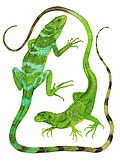| Ctenosaura flavidorsalis | |
|---|---|
| Scientific classification | |
| Kingdom: | Animalia |
| Phylum: | Chordata |
| Class: | Reptilia |
| Order: | Squamata |
| Suborder: | Iguania |
| Family: | Iguanidae |
| Genus: | Ctenosaura |
| Species: | C. flavidorsalis |
| Binomial name | |
| Ctenosaura flavidorsalis Köhler & Klemmer, 1994 | |
Ctenosaura flavidorsalis, commonly known as the yellow-backed spiny-tailed iguana, is a species of lizard in the family Iguanidae.

